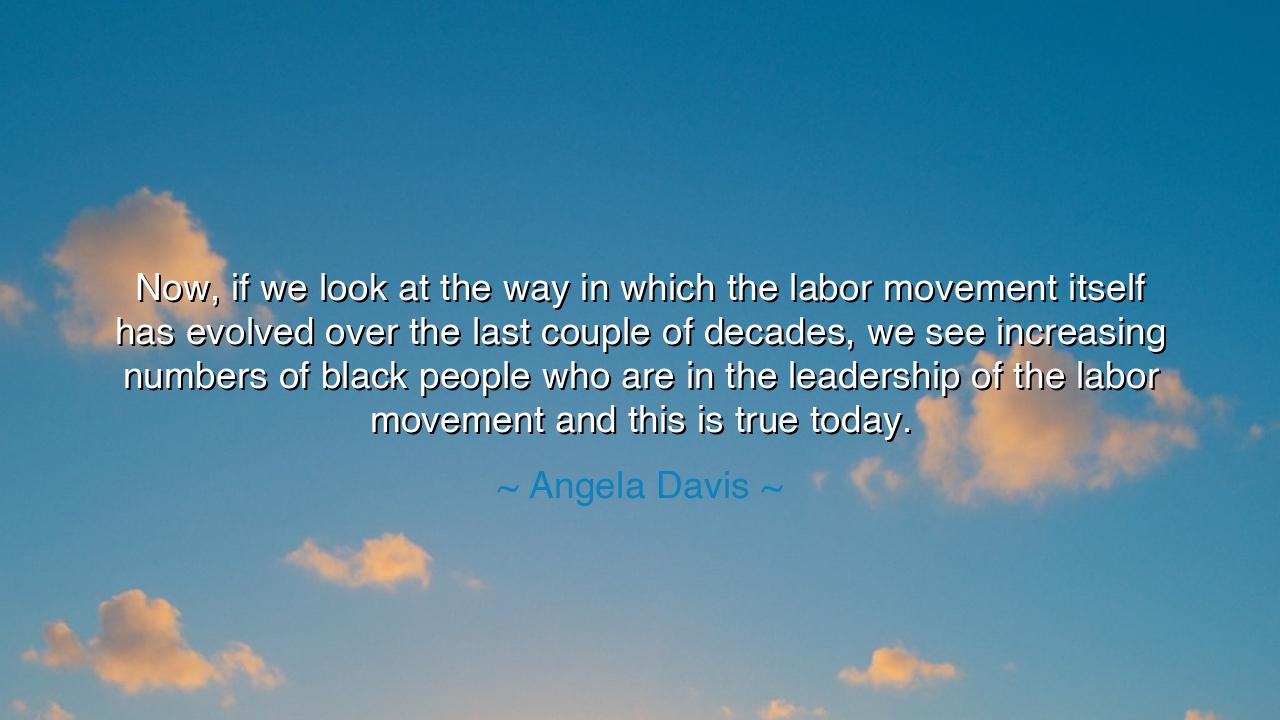
Now, if we look at the way in which the labor movement itself has
Now, if we look at the way in which the labor movement itself has evolved over the last couple of decades, we see increasing numbers of black people who are in the leadership of the labor movement and this is true today.






The words of Angela Davis—“Now, if we look at the way in which the labor movement itself has evolved over the last couple of decades, we see increasing numbers of black people who are in the leadership of the labor movement and this is true today.”—carry with them the weight of history and the rhythm of progress. Davis, herself a scholar, activist, and revolutionary voice, speaks not only of labor and leadership but of a struggle centuries old, where the oppressed have risen from the margins to take their rightful place as leaders. Her words are both a reflection and a prophecy: a recognition of how far the labor movement has come, and a call to remember that leadership must be continually broadened to reflect the people it serves.
To understand her statement, we must remember that the labor movement was born from hardship. It rose in the smoke of factories, in the fields of harvest, in the mines of coal and iron, where workers labored long hours for meager wages. Yet within that movement, racial inequality long festered. Black workers were often pushed to the most dangerous jobs, excluded from unions, or denied leadership positions even as they gave their sweat and blood to the same cause. For Davis to note the rise of black leadership within labor is to highlight a profound evolution: that the struggle for worker dignity has become intertwined with the struggle for racial justice.
History gives us a vivid example in the life of A. Philip Randolph, who organized the Brotherhood of Sleeping Car Porters in the early twentieth century. Against immense opposition, he fought not only for wages and hours but for the recognition of black workers’ dignity. He became one of the most powerful labor leaders of his time and later helped organize the 1963 March on Washington, where Dr. Martin Luther King Jr. delivered his immortal dream. Randolph’s story shows how the inclusion of black voices in labor leadership transformed not only the movement itself but the destiny of an entire nation.
Davis’s words also remind us that progress is never automatic; it is won by struggle, persistence, and sacrifice. The increasing numbers of black leaders in labor did not emerge by accident but through decades of organizing, protest, and resilience in the face of exclusion. Each leader today stands upon the shoulders of those who risked jobs, freedom, and sometimes even their lives to demand that the labor movement embody true solidarity. Her observation is thus not merely about demographics—it is about justice fulfilled in part, though never complete.
The deeper meaning of Davis’s teaching is this: a movement is only as strong as its inclusivity. To fight for wages but ignore race, to demand fairness while perpetuating exclusion, is to build a house on sand. But when the movement grows to embrace all workers—black, white, immigrant, disabled, male and female—then it becomes unbreakable, for it reflects the wholeness of humanity. Leadership that rises from the many, rather than being confined to the few, is leadership that carries the heartbeat of the people.
The lesson for us is plain. Whatever movement we serve, whether in labor, education, or justice, we must ask: who has been silenced? Who has been excluded from leadership, though their labor built the very foundation we stand upon? To honor Davis’s words is to make sure that progress means not only better conditions, but broader inclusion. Each of us must labor not only for ourselves but for those who have been denied their rightful place at the table.
So, O listener, take these words of Angela Davis as both celebration and command. Rejoice in the evolution of labor leadership that now includes those once marginalized. But do not rest in triumph—press forward. Build communities and movements where leadership is measured not by privilege, but by service, courage, and the shared struggle for justice. For as Davis reminds us, when leadership grows to embrace all, then the movement itself grows stronger, more enduring, and more true. And in such a movement, the seeds of freedom are sown for generations yet to come.






AAdministratorAdministrator
Welcome, honored guests. Please leave a comment, we will respond soon